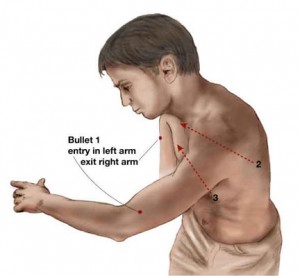Continuing with our theme of exposing limitations of previously held forensic science practices, today’s post centers around the applied science of anthropometry and bullet trajectory.
The term “ballistics” has a specialized definition in the forensic field. The term is not synonymous with the concepts of toolmark identification. Instead, Ballistics is the science of mechanics that deals with the flight, behavior, and effects of projectiles, especially bullets, gravity bombs, rockets, or the like; the science or art of designing and accelerating projectiles so as to achieve a desired performance.
Anthropometry itself is the science dealing with measurement of the size, weight, and proportions of the human being. Applied anthropometry is application of the science to some other scientific discipline.
In the context of ballistics, it is not simply the issue of the mechanics of the flight, behavior, and effects of projectiles that controls how a projectile is delivered to the target, but also is influenced by the anthropometry of the human who fired the weapon and especially if a human is the target the anthropometry of that target also plays a factor in how the path of the projectile continues until the projectile ceases to move. For example, how one holds the gun can impact the path. As one can imagine it is truly a multivariate problem requiring a lot of data.

Perhaps the seminal work on the subject Understanding Ballistics. Although it was published a little while ago, it is perhaps the first time that in a meaningful way a real credentialed scientist attempted to apply the multivariate reality of the world to the path of a bullet. Since its publication, a lot of attempts to further define the interplay of not only the bullet but also the anthropometry involved have been published.
My summary:
Understanding the Trajectory of a Bullet
Once the bullet is shot, gravity will pull the bullet down and the fall of the bullet will have a constant acceleration. This acceleration will vary depending on the density of the bullet, the air density, and the surrounding air resistance. Furthermore, the time and length of the projectile (bullet’s) flight will also weigh in to the determination of its acceleration. The longer the bullet is in the air, the longer the above mentioned factors will have to bring about change on the bullet’s flight.
Since all trajectories will curve, the type of drop will depend on the cartridge, the caliber, and the gun used. Additionally, the time that the projectile is in flight will directly relate to the amount of the drop; the less flight time, the less the drop will be as it travels. Finally, the altitude in which the bullet is fired will also affect the bullet’s drop in that as the altitude increases; the less air resistance is present thus increasing the velocity of the bullet.
When an individual aims a gun, the individual must point the sight above the object that the individual is aiming at due to the acceleration drop caused when the bullet is propelled out of the gun. Upon examining the trajectory of the bullet, most scholars have stated it is a theoretical parabolic since the projectile makes a steeper curve on its descent than on its ascent due to the longer effect of the horizontal resistance. This trajectory is theoretical in that it is not a true parabolic because the distance from the fixed line is not equal to its distance from a fixed point, which would be present in a true parabolic trajectory.


